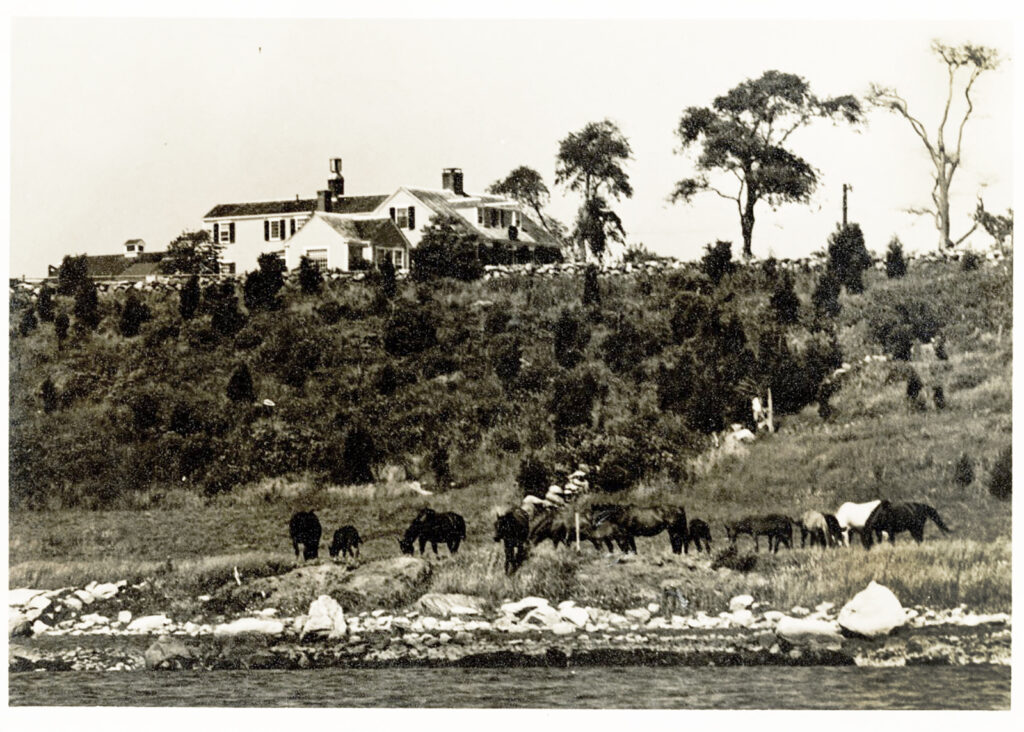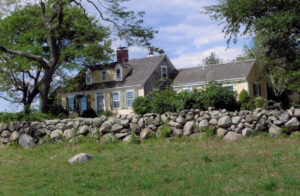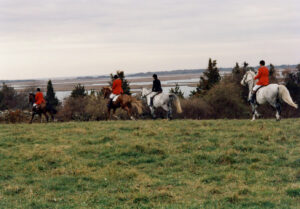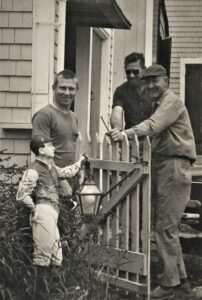Little Sunswick by Jane Tuckerman
Little Sunswick/ The Tuckerman Farm, South Westport, Massachusetts

Little Sunswick
“The Farm” we called our home. “Little Sunswick Farm”, 180 acres on the Westport River, 4 adjoining residences, all acquired at different times beginning in 1938 when my father , Bayard Tuckerman, moved from north of Boston to be near his friend Bunny Almy. Horseneck Road was frequented by horses and hounds as the two men actively participated in weekly outings of the “Quansett Hunt”. They remained close friends until my father died in 1973.

A small center chimney colonial, the main house was built around 1823 and demolished in 2004. It had been occupied by the Gifford family for several generations. Remnants of their life were discovered in n 1957, a large ceramic vat containing pickled eggs that the Giffords had stored away in the stone walled cellar. An old barn was extended in 1947 to accommodate the mares and foals. A back barn was built by my father for the cows and to host his yearly gathering of cock fight enthusiasts. There was a smoke house, several corn cribs with marble supports, an exotic bird folly in my mother’s extensive gardens, kennels for the hounds, and some very ancient sheds. Gunning Island in the middle of the Westport River was our immediate view. It was part of the farm until my mother donated it to the Audubon Society in the 1980s. The Tuell house in the middle of the property is much earlier, 1760?. This still exists, is about a quarter of a mile from the river and had a long tunnel that began in the basement of the house and extended all the way to the river. No one seems to know whether this was for rum runners or the Under Ground Railroad. There were snakes in the cellar and ghosts in the attic, many reported sightings over the years. “The North Farm” was where the stallions lived and the breeding was managed. Here, at this adjoining farm was a very old house from the early 1700’s, but because it was riddled with termites my father tore it down and replaced it in the 1950s. There is the original front door step outside the existing door. The Gate House, circa 1910, is at the head of the driveway. All the American elms have gone, but many of the specimen trees that my mother, Mitty, planted when she and my father married in 1946 still exist. Two ponds were excavated on the side of the main driveway in the 1960s, allowing some drainage of the swamp. There is a wonderful old spring at the Tuell House with remnants of old stone walls. It is a calming place in the middle of the woods and reverently produces an abundance of watercress every year. The fields produced all the hay and corn that was needed to feed the livestock. Freezers and cupboards were full of vegetables, home cooked soup, chickens, and other assorted goodies that were gathered from the fields and gardens. These riches were carefully curated then thrown into pots and pans to feed the extended family that gathered on holidays and celebrations. The Farm was our pilgrimage place.

At one time in the 1950s and 60s my mother and father had 85 Thoroughbred horses that were destined for racetracks all over the East Coast. There were many foals each spring, two ponies, two donkeys, chickens, a milking cow, black angus cattle for the freezer, and a huge pig pen with nasty aggressive pigs. Occasionally a few sheep, never goats, and about 10 miscellaneous dogs running about, fighting, or chasing the horses, some big, some small, always hairy and dirty, all would be munching the rich grass or lounging and cavorting. The Waldingfield Beagles, the oldest continuous hunting pack in the US, having belonged to a close cousin, my mother felt that it was imperative that the pack be kept intact. Once or twice a year a professional huntsman would come from Virginia and take all the hounds over to No Man’s land by boat and have a great rabbit hunt. One of these huntsman was a good friend of the actress Bette Davis. I remember her visiting and coming up to say goodnight to my sister and I. We always had lots of visitors. There was Dr Veit, who came every weekend. She lived in Newport and was Jackie Kennedy’s dermatologist. Very personable, Vitamin as we called her, would discretely tell us tales of the Kennedy clan and gossip about the Newport elite. Also, my mother once confided to me that a man staying at the farm was one of the three people responsible for activating the nuclear button.
The horses were the main attraction. My father bred race horses that went on to be very successful on east coast tracks. My mother named them. This was a yearly ritual around the kitchen table: a name had to be original, then it would be attached to documentation that included a picture of the foal, vital statistics and sent into the Jockey Club. Sometimes this form would be returned because the chosen name had already been used by another owner. My father was one of the original founders of the Suffolk Downs Racetrack in Boston, was a member of the prestigious Jockey Club and was inducted into the racing hall of fame in Saratoga, N.Y. My mother bred a horse that was bought and ridden by a local Westport person, Kerry Miillikin, at the Atlanta Olympics. She won a bronze medal. My sister, Susan, grew up riding with Bruce Davidson who lived on Horseneck Road and he ultimately became one of the worlds most renowned horseman. He has a bronze life-size statue of him and his World Champion mount at the US Equestrian headquarters in Lexington , Kentucky. Peter Wylde, another local Olympian bought a very successful horse from my sister and the farm. My horse won a class at the National Horse show in the hunter division.

Little Sunswick
So the legacy lives on. We carefully put the property into an APR, an Agricultural Protection Restriction Program so that the land will remain open space, a farm, a habitat for centuries. All of us are responsible for the preservation of these special places and a respect for their history. The history that is embedded in the old wooden structures, the deep rich soil and the meandering stone walls. I always maintain that nobody ever leaves a place, they just step aside for a while.
Jane Tuckerman
